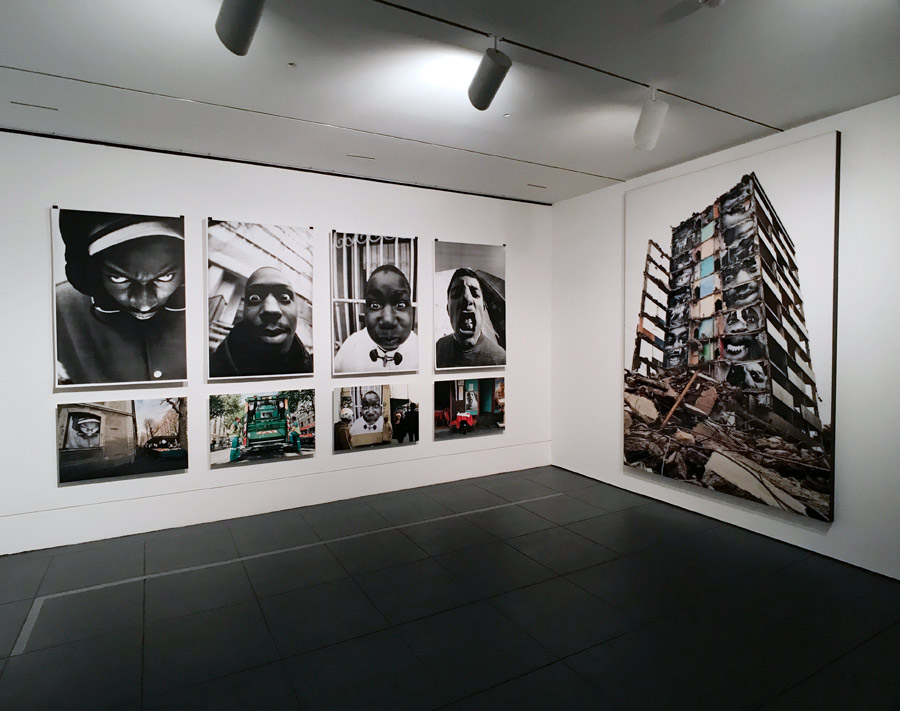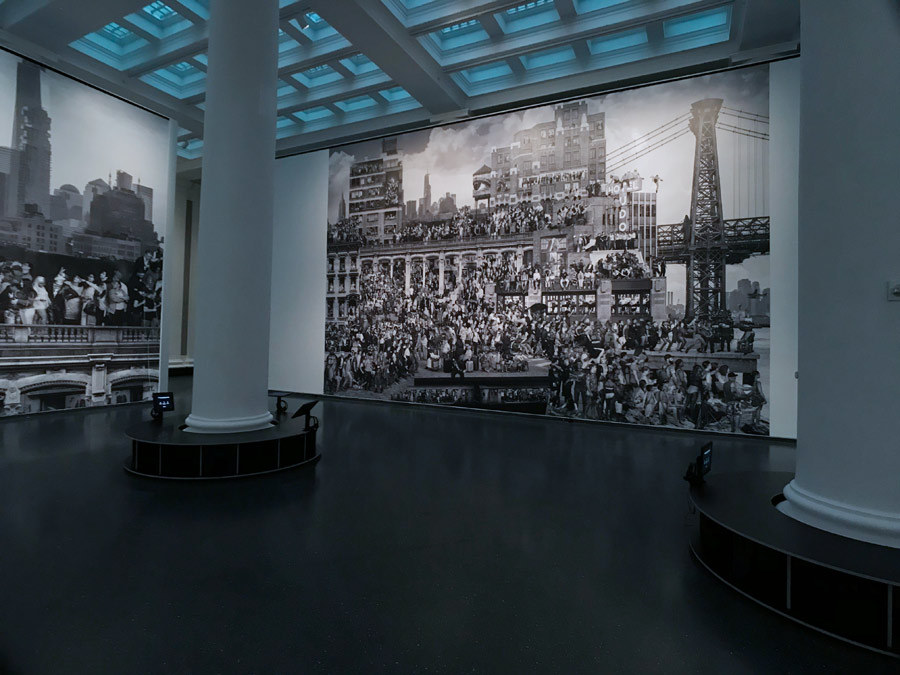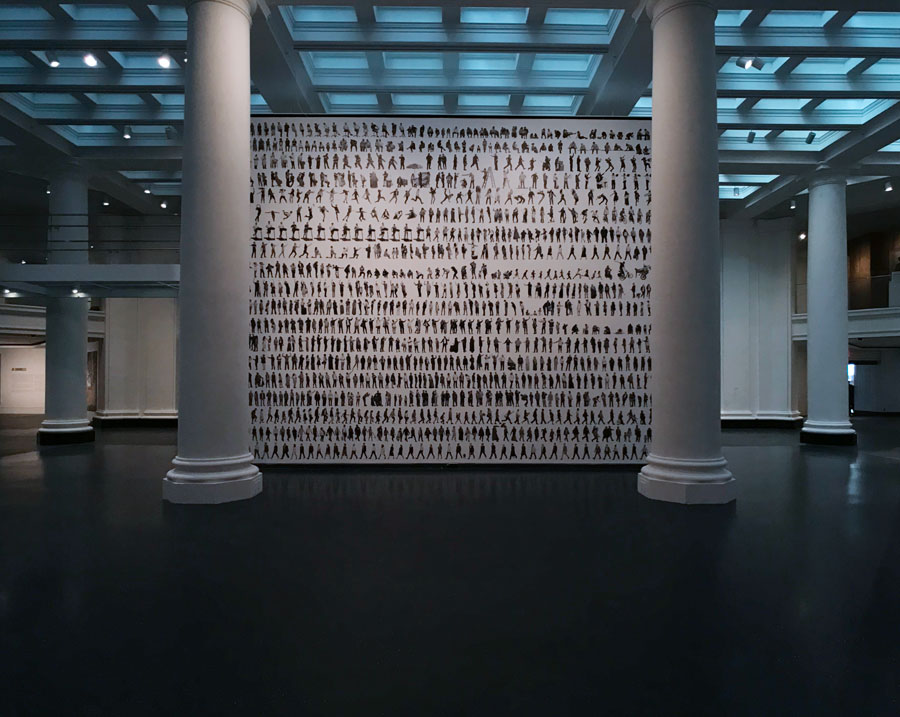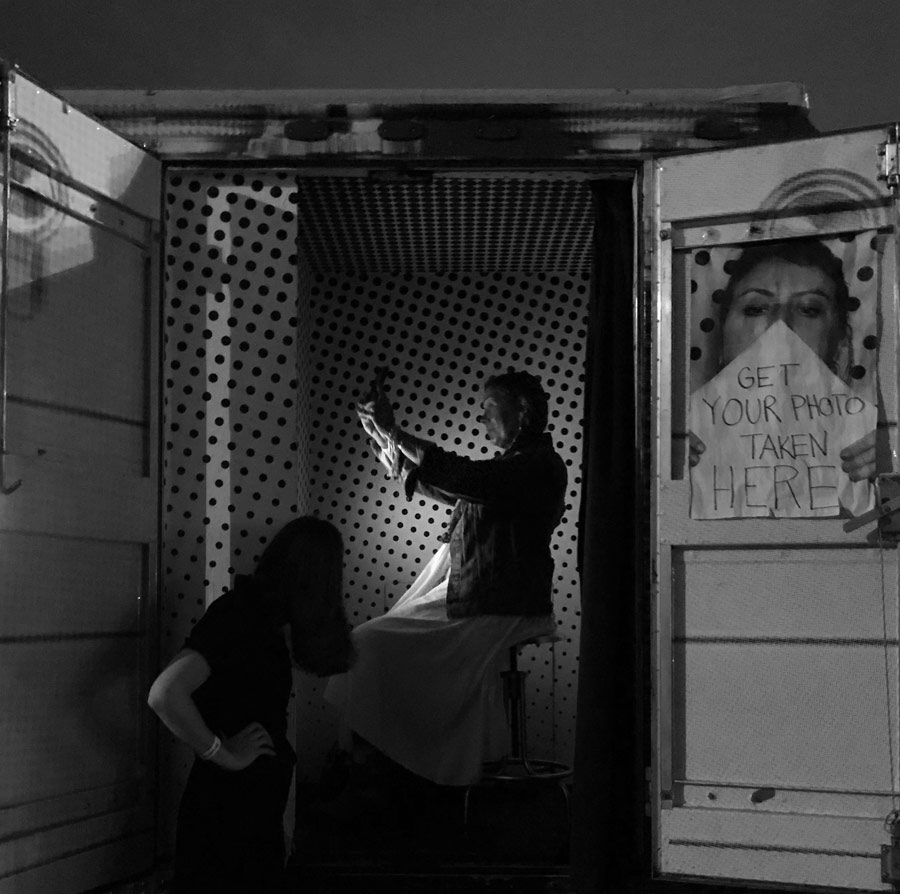A retrospective at Brooklyn Museum currently showcases the photographic works and public projects envisioned and created by French Street Artist JR. Covering roughly two decades of work, JR: Chronicles dedicates an in-depth examination into his practices and personal philosophies when creating – as evidenced by this collection of his murals, photographs, videos, films, dioramas, and archival materials.

JR: Chronicles. Brooklyn Museum. Brooklyn, NY (photo © Jaime Rojo)
(For more information please see image description A below)
His most recent and one of his most original ideas has been to use the techniques of professional film compositing to impart a permanent, living aura for what may otherwise be static collaged works. With high res digital works working in concert, the life of the subject takes on an additional dimension, juxtaposed as it is with other figures they may or may not have ever interacted with.

Often in these recent projects you have the opportunity to see and/or hear personal recordings of the person through interviews for the piece. The centerpiece and partial namesake of this show is the new large-scale mural of more than one thousand New Yorkers whom he chose to feature, accompanied by audio recordings of each person’s story as told to him and his team.

JR found this camera in the Paris Métro and began taking pictures of graffiti artists in the tunnels and on the roofs of Paris.
Many of these concepts and philosophical observations, including sociopolitical commentary on a number of hot-button issues of the day, may feel familiar to fans and Street Artists around the world – particularly over the last decade and a half. Here you can see that with the number of resources and teams that he can amass, JR is able to create the ideas with a sense of largesse and garner greater audiences, putting many of his works before many more.
Epic is a word often used to describe the projects, and when you see the JR: Chronicles exhibition you can understand why.

We spoke with the curators of the exhibition Sharon Matt Atkins and Drew Sawyer about their experience with this exhibition and how JR is defining new areas of photography with his use of it in public space.
Brooklyn Street Art: JR created a new digital collage for this exhibition featuring a thousand or so people individually interviewed and photographed. Can you tell us about what criterion he used for selecting his subjects?
Sharon Matt Atkins: JR’s main focus was on capturing the rich diversity of New York City. As such, he photographed people in all five boroughs of the city, including many neighborhoods that were new to him. While he did invite some guests to participate, most of the people were passersby, or business owners and workers of local stores.

Brooklyn Street Art: It may be that there has been a return to
black and white photography in
the last decade – so much so that one may not register the significance
that JR employs it for expression almost exclusively. How do you think
the limited palette aids his work in telling his narratives?
Drew Sawyer: In
many ways, JR’s use of black and white photographs is in direct
opposition to contemporary photojournalism and the digital circulation
is images. His close-up portraits may recall the work of earlier
documentarians, such as Gordon Parks and Dorothea Lange in the United
States, but JR’s decision to print them on inexpensive paper and paste
them nearby counters they ways in which images often circulate in the
global media far away from the places where his collaborators live. Also,
the monochromatic images certainly stand out against the colorful built
environments in which JR typically installs them.

(For more information please see image description B below)
Brooklyn Street Art: As you deeply analyzed his career and its
various phases, what would you
say is one of the through-lines that you see in his practice as it
evolved?
Sharon Matt Atkins:
Our show is centered on his projects that have been created in
collaboration with communities. From his earliest photographs
documenting his graffiti writer friends to Inside Out with more
than 400,000 participants in 141 countries to his most recent mural The
Chronicles of New York City, JR has sought to give visibility to those
often underrepresented or misrepresented.

Brooklyn Street Art: How has JR used his work in a new way that may prove to be inspiring to photographers and fans of photography?
Drew Sawyer: For JR, photography is just one part of his collaborative process. His work is really about bringing people together, lifting the voices of others who rarely have control over their own representation, countering narratives in the global media, and shifting the discourse around specific issues and events. He started his practice before there were social media apps like Instagram, which now provide platforms for many people to do the same in a digital form. Since then, JR has explored how new technologies can help him tell and share more stories. I hope his process inspires other artists to use photography in similar and new ways.

(For more information please see image description below)
“Since 2017 JR has been creating participatory murals inspired by the work of the Mexican painter Diego Rivera in the first half of the twentieth century. In the summer of 2018, JR and his team spent a month roaming all five boroughs of New York City, parking their 53- foot-long trailer truck in numerous locations and taking photographs of passersby who wished to participate. Each was photographed in front of a green screen, and then the images were collaged into a New York City setting featuring architectural landmarks. More than a thousand people were photographed for the resulting mural, The Chronicles of New York City. The participants chose how they personally wanted to be represented and were asked to share their stories, which are now available on a free mobile app.”
– text courtesy Brooklyn Museum










(See image description below)
“In January 2009 JR carried out another iteration of Women Are Heroes in Kibera, Kenya, one of the largest slums in Africa. Following close dialogue with the community, JR covered rooftops with water-resistant vinyl printed with photographs of the eyes and faces of local women. The images both transformed the landscape and provided protection from the rain.
The train that ran along the Kibera line was also covered with photographs of the eyes of women who lived directly below, and images of the lower halves of their faces were pasted on the slope beneath the tracks so that as the train passed, their faces were completed for a few seconds. The idea was to celebrate, or at the very least to acknowledge their presence.
Of his projects, JR has said, ‘I search with my art to install the work in improbable places, to create with the communities projects that promote questioning. . . and to offer alternative images to those of the global media.’ ”
– text courtesy Brooklyn Museum

(See image description below)
“On October 8, 2017, for the last day of the Kikito installation at the U.S.-Mexico border, JR organized a gigantic picnic on both sides of the wall. Kikito, his family, and dozens of guests came from the United States and Mexico to share a meal. People at both sides of the border gathered around the eyes of Mayra, a ‘Dreamer,’ eating the same food, sharing the same water, and enjoying the same live music (with half the band’s musicians playing on either side). “
– text courtesy Brooklyn Museum




JR: Chronicles is curated by Sharon Matt Atkins, Director of Exhibitions and Strategic Initiatives, and Drew Sawyer, Phillip Leonian
Image Description A (see earlier in article)
“As the first photograph in what would become JR’s Portrait of a Generation, this image launched his career. The series was initiated when Ladj Ly, a filmmaker, and resident of Cité des Bosquets (called “Les Bosquets”), a public housing complex in the Parisian suburb of Montfermeil, invited JR to collaborate on a project in the neighborhood.
JR said of the image: ‘I took this picture when I was eighteen. It was the first time I went to Les Bosquets. If you look carefully in the back, you can see small posters from Expo 2 Rue—and I wrote ‘Expo D Boske.’ The kids asked me if I could take a picture of them. This photo of Ladj Ly filming me was the first one on the roll of film, and I felt something special had happened. This image is very emblematic of my work and of the message of this project with Ladj.’
This photograph was also the first large-scale image that JR and his friends wheat-pasted in the neighborhood prior to the riots there in 2005. It appeared as the backdrop in photographs accompanying newspaper articles and television footage about the uprising, thereby becoming JR’s first published work. “
– text courtesy Brooklyn Museum
Image Description B (see earlier in article)
“In 2013 JR learned that the housing towers in Les Bosquets were going to be demolished, so he revisited the Portrait of a Generation project. Using images from the original series, he and a team pasted portraits in the building before it was destroyed. He recalled, ‘We couldn’t get authorization to paste inside. So we got plans from the former inhabitants, and we entered at night, twenty-five of us, and spread out over all the different floors. We pasted eyes in someone’s kitchen, a nose in someone else’s bathroom, and a mouth in a living room. . . . When we came down, the police arrested us, but they couldn’t understand why we had just spent hours in this building that was about to be destroyed. The pastings were so big that they couldn’t see what they were. The next day, when workers started the demolition, the portraits were revealed, little by little, while the cranes were ‘eating’ the building. Only the people who were in the neighborhood that day witnessed the gigantic spectacle unfold.’ “
– text courtesy Brooklyn Museum
Other Articles You May Like from BSA:
Spanish street artist SpY has been stretching the limits, blurring the lines, if you will, between street art, installation art, and creating “situations” in cities for the last decade. In this new s...
When Jan Sauerwald, Urban Nation's Artistic Director, began making plans in earnest for the new facade for the museum, he was pondering what the art on the walls should convey. Given the difficult Co...
In Amsterdam the temperature is above freezing and the trees are beginning to show little buds on the branches. With any luck this new “spring offering” by Skount and Pau Quintana Jornet will usher in...
MONUMENTA: The Intelligence Of Many. Below is an excerpt from our press release on this weekend's MONUMENTA TALKS which BSA is hosting for the opening of the Monumenta exhibition in these...
Welcome to BSA Images of the Week. Happy Hannukah to all our Jewish friends this week as the festival of lights began on Thursday night. “Chag Sameach!” Meanwhile, the Christmas jam is in f...
 BROOKLYN STREET ART LOVES YOU MORE EVERY DAY
BROOKLYN STREET ART LOVES YOU MORE EVERY DAY










